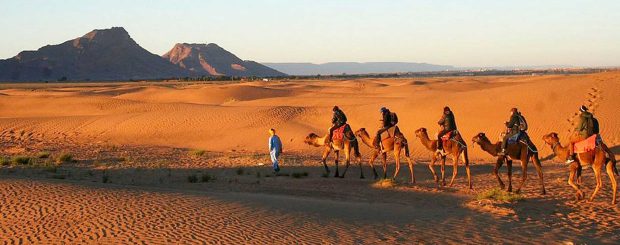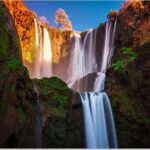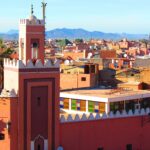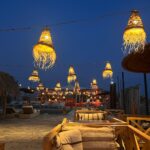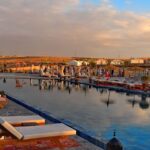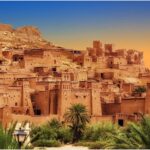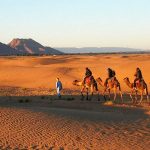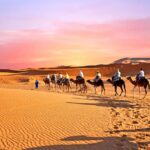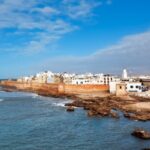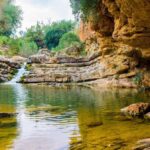Exploring Morocco and the Sahara Desert: A Journey into History, Culture, and Natural Wonders
Morocco is a country in North Africa that is known for its rich cultural heritage, diverse geography, and stunning natural landscapes. One of the most iconic features of Morocco is the Sahara Desert, which covers much of the southern part of the country. This vast expanse of sand dunes, rocky plateaus, and oases has long captivated travelers, adventurers, and explorers. In this article, we will delve into the history, culture, and natural wonders of Morocco and the Sahara desert.
I. The History of Morocco and the Sahara Desert
Morocco has a long and complex history that dates back thousands of years. The earliest known inhabitants of the region were the Berbers, a group of indigenous peoples who lived in North Africa long before the arrival of the Arabs. Over the centuries, the Berbers developed a rich and diverse culture, with their own languages, customs, and traditions. They also established a number of powerful empires, including the Almoravid, Almohad, and Marinid dynasties, which controlled much of North Africa and Spain.
In the 7th century, Islam was introduced to Morocco by Arab invaders, and it quickly became the dominant religion in the region. Over the centuries, Moroccan Islam evolved into a unique blend of Sunni Islam and traditional Berber beliefs, with a strong emphasis on Sufism, a mystical branch of Islam that emphasizes spiritual insight and personal experience.
Throughout the centuries, the Sahara desert has played a key role in the history of Morocco. The desert was a major trade route between West Africa and the Mediterranean, and it was crossed by caravans of traders, pilgrims, and adventurers. The desert was also the site of several important battles and conflicts, including the French conquest of Morocco in the early 20th century.
II. Culture and Traditions of Morocco and the Sahara Desert
Moroccan culture is a vibrant and diverse mix of Berber, Arab, and African influences. The country is home to a rich tradition of music, art, and literature, with a strong emphasis on storytelling and oral history. Moroccan cuisine is also famous around the world, with its mix of savory spices, sweet flavors, and diverse ingredients.
The Sahara desert has its own unique culture and traditions, shaped by the harsh environment and the nomadic lifestyle of the desert peoples. The Tuareg, for example, are a nomadic Berber people who have lived in the Sahara for centuries. They are known for their distinctive blue robes, silver jewelry, and intricate tattoos, as well as their music, poetry, and storytelling.
Another important aspect of Saharan culture is the role of the camel, which has been a vital part of desert life for thousands of years. Camels are used for transportation, food, and even as a form of currency. They are also highly respected and revered by the desert peoples, who consider them to be symbols of endurance, strength, and resilience.
III. Natural Wonders of Morocco and the Sahara Desert
Morocco is home to a wide variety of natural wonders, from the rugged Atlas Mountains to the lush forests of the north. But perhaps the most iconic natural feature of Morocco is the Sahara desert. This vast expanse of sand and rock covers much of the southern part of the country, and it is one of the largest deserts in the world.
The Sahara is home to a stunning array of natural wonders, including towering sand dunes, rocky plateaus, and hidden oases. One of the most famous attractions in the Sahara is the Erg Chebbi dunes, a massive sea of golden sand that stretches for miles. Visitors can ride camels through the dunes, watch the sunrise and sunset, and even camp overnight in a traditional Bedouin tent.

Another popular destination in the Sahara is the Draa
Valley, a long and narrow oasis that runs through the heart of the desert. The valley is home to date palm groves, lush gardens, and traditional villages, and it provides a vital source of water and resources for the desert communities.
The Sahara is also home to a number of unique and fascinating animal species, including the dromedary camel, the sand cat, the desert hedgehog, and the fennec fox. These animals have adapted to the harsh desert environment and have developed a range of survival techniques, such as hibernation, burrowing, and conserving water.
Beyond the Sahara, Morocco is also home to a number of other natural wonders, such as the Cascades d’Ouzoud waterfalls, the Todra Gorge canyon, and the Merzouga desert. These sites offer stunning views, unique experiences, and a glimpse into the natural beauty of Morocco.
IV. Travel Tips and Considerations
If you are planning to visit Morocco and the Sahara desert, there are a few things to keep in mind. First and foremost, it is important to be prepared for the hot and dry climate of the desert. Make sure to bring plenty of water, sunscreen, and protective clothing, and be aware of the signs of heat exhaustion and dehydration.
It is also important to be respectful of local customs and traditions, particularly when visiting traditional villages and communities. Dress modestly, avoid public displays of affection, and ask for permission before taking photographs or entering private spaces.
When traveling in the desert, it is advisable to hire a reputable guide or tour operator who can provide you with the necessary equipment, knowledge, and support. They can also help you navigate the terrain, avoid potential dangers, and discover the hidden wonders of the desert.
In conclusion, Morocco and the Sahara desert are a fascinating and unique destination that offer a wealth of history, culture, and natural beauty. Whether you are interested in adventure, relaxation, or exploration, Morocco has something to offer for everyone. So pack your bags, grab your camel, and get ready for an unforgettable journey into the heart of the desert.
FAQs:
What is the best time of year to visit Morocco and the Sahara desert?
The best time to visit is typically during the cooler months of October to April, as temperatures can soar to over 100°F in the summer months.
Is it safe to travel to Morocco and the Sahara desert?
Morocco is generally considered a safe destination for travelers, and the government places a high priority on tourist safety. However, as with any travel, it is important to take precautions and be aware of your surroundings.
What are some must-see attractions in Morocco and the Sahara desert?
Some popular attractions include the Hassan II Mosque in Casablanca, the blue city of Chefchaouen, the ancient city of Fes, and the sand dunes of Erg Chebbi in the Sahara desert.
How do I prepare for a trip to the Sahara desert?
It is important to bring plenty of water, sunscreen, and protective clothing, as well as to hire a reputable guide or tour operator who can provide necessary equipment and support.
What is the Berber culture and how can I learn more about it?
The Berber culture is the indigenous culture of North Africa, including Morocco. You can learn more about it by visiting traditional Berber villages, attending cultural events, and reading about the history and traditions of the Berber people.
Related Tours:

